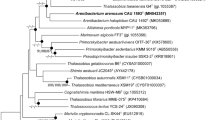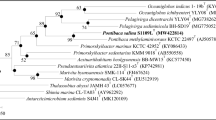Abstract
A Gram-stain-negative, slightly curved, rod-shaped bacterial strain CAU 1517T was isolated from marine sediment in Busan, the Republic of Korea. The taxonomic position of strain CAU 1517T was investigated via a polyphasic approach comprising phenotypic, chemotaxonomic and phylogenetic properties. Strain CAU 1517T grew optimally at 30 °C, pH 7.5 and in the presence of 7% (w/v) NaCl. Phylogenetic analysis based on 16S rRNA gene sequencing revealed that strain CAU 1517T belongs to the genus Halarcobacter and is most closely related to Halarcobacter bivalviorum LMG 26154T (96.5% similarity). The average nucleotide identity and digital DNA-DNA hybridization values between strain CAU 1517T and members of genus Halarcobacter ranged from were 76.7–78.0% and 19.5–21.2%, respectively. The strain contained menaquinone-6 (MK-6) as the only respiratory quinone, and C16:0, summed feature 3 (C16:1 ω7c/C16:1 ω6c), and summed feature 8 (C18:1ω7c/C18:1ω6c) as the major fatty acids. The polar lipid pattern consisted of diphosphatidylglycerol, phosphatidylethanolamine, and two unidentified aminophospholipids. The G+C content was 28.2 mol%. Therefore, it has been demonstrated that the isolate represents a novel species of the genus Halarcobacter, for which the name Halarcobacter arenosus sp. nov., is proposed. The type strain is CAU 1517T (=KCTC 72232T =NBRC 113955T).

Similar content being viewed by others
References
Cappuccino JG, Sherman N (2002) Microbiology: a laboratory manual, 6th edn. Benjamin/Cummings, Menlo Park
Felsenstein J (1981) Evolutionary trees from DNA sequences: a maximum likelihood approach. J Mol Evol 17:368–376
Goris J, Konstantinidis KT, Klappenbach JA, Coenye T, Vandamme P, Tiedje JM (2007) DNA–DNA hybridization values and their relationship to whole-genome sequence similarities. Int J Syst Evol Microbiol 57:81–91
Jyothsna TS, Rahul K, Ramaprasad EVV, Sasikala C, Ramana CV (2013) Arcobacter anaerophilus sp. nov., isolated from an estuarine sediment and emended description of the genus Arcobacter. Int J Syst Evol Microbiol 63:4619–4625
Kim JH, Kanjanasuntree R, Kim DH, Lee JS, Sukhoom A, Kantachote D, Kim W (2019) Arenibacillus arenosus gen. nov., sp. nov., a member of the family Rhodobacteraceae isolated from sea sand. Int J Syst Evol Microbiol 69:153–158
Komagata K, Suzuki KI (1988) 4 Lipid and cell-wall analysis in bacterial systematics. Methods Microbiol 19:161–207
Larkin MA, Blackshields G, Brown NP, Chenn R, McGettigan PA, McWilliam H, Valentin F, Wallace IM, Wilm A, Lopez R, Thompson JD, Gibson TJ, Higgins DG (2007) Clustal W and Clustal X version 2.0. Bioinformatics 23:2947–2948
Levican A, Collado L, Aguilar C, Yustes C, Diéguez AL, Romalde JL, Figueras MJ (2012) Arcobacter bivalviorum sp. nov. and Arcobacter venerupis sp. nov., new species isolated from shellfish. Syst Appl Microbiol 35:133–138
Levican A, Rubio-Arcos S, Martinez-Murcia A, Collado L, Figueras MJ (2015) Arcobacter ebronensis sp. nov. and Arcobacter aquimarinus sp. nov., two new species isolated from marine environment. Syst Appl Microbiol 38:30–35
Minnikin DE, Odonnell AG, Goodfellow M, Alderson G, Athalye M, Schaal A, Parlett JH (1984) An integrated procedure for the extraction of bacterial isoprenoid quinones and polar lipids. J Microbiol Methods 2:233–241
Nam SW, Kim W, Chun J, Goodfellow M (2004) Tsukamurella pseudospumae sp. nov., a novel actinomycete isolated from activated sludge foam. Int J Syst Evol Microbiol 54:1209–1212
Pérez-Cataluña A, Salas Massó N, Dieguez AL, Balboa S, Lema A, Romalde JL, Figueras MJ (2019) Corrigendum (2): revisiting the taxonomy of the genus Arcobacter: getting order from the chaos. Front Microbiol 10:2253
Rodriguez-Valera F, Ruiz-Berraquero F, Ramos-Cormenzana A (1981) Characteristics of the heterotrophic bacterial populations in hypersaline environments of different salt concentrations. Microb Ecol 7:235–243
Saitou N, Nei M (1987) The neighbor-joining method: a new method for reconstructing phylogenetic trees. Mol Biol Evol 4:406–425
Yoon SH, Ha SM, Kwon S, Lim J, Kim Y, Seo H, Chun J (2017) Introducing EzBioCloud: a taxonomically united database of 16S rRNA gene sequences and whole-genome assemblies. Int J Syst Evol Microbiol 67:1613–1617
Acknowledgement
This work was supported by a grant from the National Institute of Biological Resources (NIBR), funded by the Ministry of Environment (MOE) of the Republic of Korea (NIBR201902203) and the Chung-Ang University Research Grants in 2019.
Author information
Authors and Affiliations
Corresponding author
Ethics declarations
Conflict of interest
The authors declare that there are no conflicts of interest.
Additional information
Communicated by Erko stackebrandt.
Publisher's Note
Springer Nature remains neutral with regard to jurisdictional claims in published maps and institutional affiliations.
The GenBank/EMBL/DDBJ accession number for the 16S rRNA gene sequence of strain CAU 1517T is MK280766 and the Whole Genome Shotgun sequencing project accession number is VANU00000000.
Electronic supplementary material
Below is the link to the electronic supplementary material.
Rights and permissions
About this article
Cite this article
Baek, J., Jeong, J., Kim, JH. et al. Halarcobacter arenosus sp. nov., isolated from marine sediment. Arch Microbiol 203, 817–822 (2021). https://doi.org/10.1007/s00203-020-02075-8
Received:
Revised:
Accepted:
Published:
Issue Date:
DOI: https://doi.org/10.1007/s00203-020-02075-8




